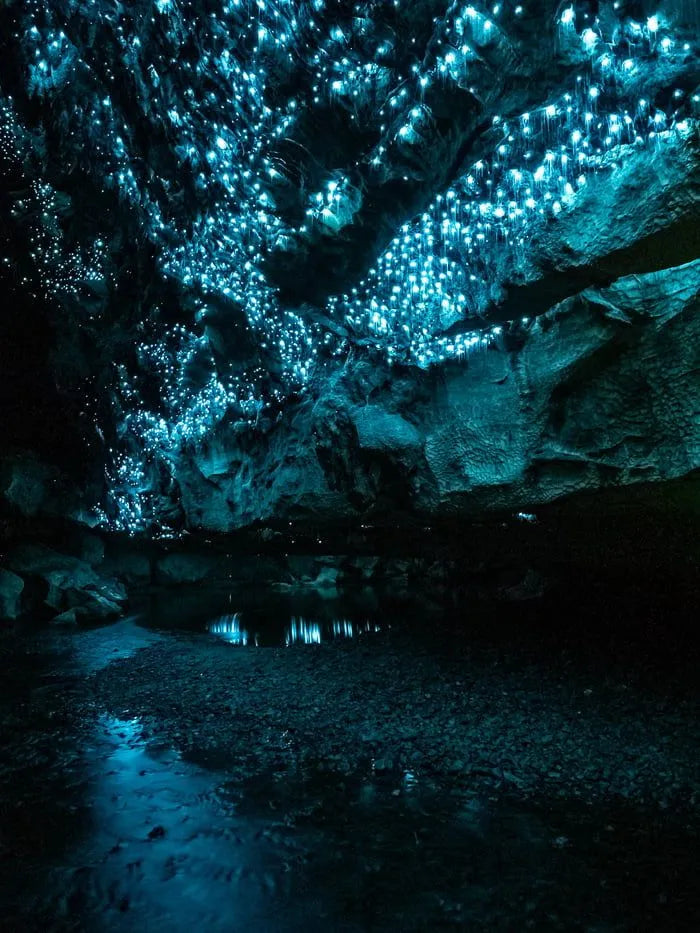Close your eyes and imagine a glow worm. What do you picture? If you are old enough, perhaps that weird little toy from the 80's and 90's with a human baby head and a long, segmented body? What in the heck was that thing? Surprisingly, that toy was somewhat accurate! That's because the term 'glow worm' refers to a larval insect, rather than a true worm, and so it would indeed have a segmented body and a little head (just not a human one). But what kind of insect is a glow worm? Well, that depends!


In the Eastern United States the the term glow worm refers to the much-beloved firefly. Despite their name, fireflies are actually beetles in the family Lampyridae, and like all beetles, fireflies have a larval stage that is caterpillar or worm-like. Many (but not all), species of firefly are bioluminescent as adults. The languid wanderings of males looking for mates are of course a familiar summer evening sight. But did you know that ALL firefly species glow as larva?? This is because larva evolved glowing capabilities first, as a warning sign to predators that they contain toxins that make them unpalatable. And here we have our original glow worm!


In some firefly species, females retain their larval-like appearance even as adults. This type of adult female is referred to as "larviform" and many female species in the Eastern firefly genus Photinus glow in their larviform state. Like a radiant Jabba the Hutt, they simply lay around giving flash responses to males of their own species and wait for suitors to come to them. Firefly flashes have different colors, frequencies, and patterns depending on their species. This helps male fireflies find the right mates.

But the glow worm hits don't stop there! Beetles in the family Phengodidae, aka the glowworm beetles, can be found from Canada to Chile, and like fireflies, larva and larviform females have bioluminescent organs that emit light. Winged males fly at night, attracted to the yellow or green lights of females, and may or may not be luminescent themselves.


Railroad worms are a special group in the Phengodidae, and they are coming into the station HOT. The red head lights and yellowish-green spots that glow along the length of the bodies of larva and larviform females resemble the windows of train cars internally illuminated in the night. In this case, the light that females emit does not appear to be used to attract males, but rather, is used as a warning of unpalatability and scare tactic to nocturnal predators. Adult males in this genus have large floofy antennae that they use to follow the female's pheromones.

If you thought we were out of glow worms by now think again! We've still got some unaccounted for, and for that we've got to pack our bags and head DOWN UNDER to the big upside-down, where cheeseburgers eat people and carnivorous fly larvae roam! Well, in caves at least. Arachnocampa is a genus of nine fungus gnat species which have a bioluminescent larval stage, akin to the larval stage of glowworm beetles. Gnats are members of the order Diptera (flies), and just like beetles, have a larval or caterpillar-like stage.


Arachnocampa species are endemic to Australia and New Zealand, where they can be found in caves and grottos, or sheltered places deep in forests where they are protected from the wind. The larva spins a nest out of silk on the ceiling of the cave and then hangs down as many as 70 threads of silk (called snares) from around the nest, each up to 11 to 15 inches long and holding droplets of mucus. In some species, the droplets of mucus on the silk threads are poisonous, enhancing the trap's ability to subdue prey quickly.


A larva's glow attracts small arthropod prey into its threads, and when a prey animal is caught by a snare, its larva pulls it up (at up to about 2 mm a second) and feeds on the prey. Caves covered with glowing larva can look remarkably like a blue starry sky at night.

So you see, the world is full of many amazing glowing larval insects that we call worms. "Worms" in the way most people think of them, like the common earthworm, are quite different than insect larvae though! Worms do belong to the kingdom Animalia. In that sense they are related to you and me and insects and every other animal on the planet. But the Kingdom Animalia is broken up into 31 different groups or "Phylums" of animals. Earthworms belong to the phylum Annelida, and nematode worms and roundworms belong to the phylum Nematoda. Flatworms, like the notorious tapeworm, belong to the Platyhelminthes. Phylums are huge groupings of related organisms containing tens of thousands to hundreds of thousands of species. They may look superficially like larval insects, but they are on a very distant branch of the evolutionary tree.

All that being said, there are true worms that glow! Diplocardia longa is a species of earthworm from the Southern United States that is able to secrete a bioluminescent slime that emits a bluish glow, which just might make it the most beautiful slime there is. It is thought that Diplocardia longa uses its luminous slime to startle predators.
Insects belong to the Phylum called the Arthropoda, or arthropods if ya' nasty. This group contains three classes: Arachnida (arachnids), Crustracea (crustaceans), and Insecta, or insects. Unlike true worms, arthropods have a hardened exoskeleton made of chitin, and paired, jointed appendages in either the larval and adult stage, or just the adult stage, and they also generally have a somewhat distinct-looking little head, like our firefly larvae.
And since we are on the subject, the 'worm' in your tequila? Look again......moth larva!
